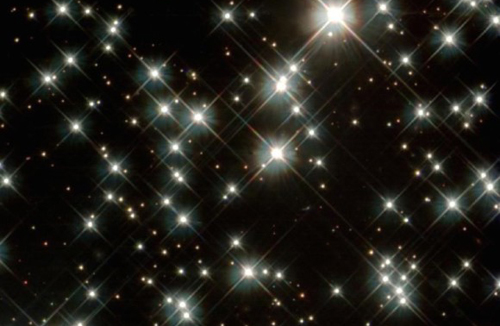9 interesting things about stars
The Sun is just one of many stars in the universe, hidden mysteries waiting for people to discover.
Interesting things about stars
1. Brightness
Every star whose human eyes can see in the sky is bigger and brighter than the Sun many times. Of the 50 brightest stars humans see with the naked eye on Earth, the star with the lowest brightness is Alpha Centauri. However, it is still 1.5 times brighter than the Sun and is not easily visible in the northern hemisphere.
2. Number of observations at night
On nights without the moon or any other light source around, a person with good vision sees about 2,000 - 2,500 stars at the same time. So if someone says to see millions of stars in the sky, that's just an exaggeration.

The colors of the star are often ranked in order of low to high temperature, which is red, orange, yellow, white, blue.(Artwork: NASA)
3. Colors
In fact, the star changes color when its temperature changes. Red represents the lowest temperature at which the star can glow in the visible spectrum. The hotter stars emit white light, the blue star has the hottest temperature.
4. Stars are black objects
Black objects are objects that absorb 100% of all electromagnetic radiation (light, radio waves .) when shining on it. In the case of the star, it absorbs all incoming radiation energy, and emits radiation into the space more than the amount of absorption many times. Therefore, they are black objects that emit strong light. The black object is more perfect than the black hole, but it seems really black and does not emit light.
5. No green star
Astronomers do not observe the green in any star, except the optical effect due to the telescope, or the view of the observer and the level of contrast. The star that emits a spectrum including green, but connects the eye - the human brain blends colors together in a way that rarely produces green. It is mixed with many other colors and the star appears white. Common colors in the order of low to high temperature are red, orange, yellow, white, blue.
6. Colors of the Sun.
The Sun has a surface temperature of more than 5,800 degrees Celsius , which corresponds to a continental wavelength (about 500 nanometers). However, when the human eye observes colors, the Sun now appears white or even yellowish white.
7. The Sun is a dwarf

The Sun is just one of many stars in the universe.(Photo: ShutterStock)
Stars produce energy by maintaining and synthesizing hydrogen including dwarfs, massive stars and super-massive stars. Large stars and supernovae represent the final stage of the star, while the majority of smaller stars belong to the evolutionary maturity stage called dwarfs . The Sun is a dwarf, sometimes called " dwarf gold".
8. The star is not flashing
The stars look bright, especially when they appear near the horizon. When light from a star passes through the turbulent atmosphere of the Earth, it must penetrate through many layers of different air so it changes in color and light intensity, making them seem to glow. This phenomenon does not happen if we look at the star above the Earth's atmosphere.
9. Distance
On the beautiful night, we can see the Deneb star in the constellation Cygnus , about 32 million billion km away. This is the most visible star in the sky on autumn night, winter everywhere in the northern hemisphere.
- Going from one surprise to the other is different from the interesting things about all things
- 10 interesting things about life you may not know
- Interesting things about TV around the world that you may not know
- 10 interesting things about nature you may not know
- Super interesting things about math you will definitely fall back
- 12 horrible things about China you may not know
- Animal World - Interesting things you don't know
- 10 interesting things about cats
- 10 interesting things about the Internet that you don't know
- Discover interesting things about rain
- Some interesting things about eclipse
- Extremely little-known secrets about the FBI - America's leading famous investigative bureau
 Van Allen's belt and evidence that the Apollo 11 mission to the Moon was myth
Van Allen's belt and evidence that the Apollo 11 mission to the Moon was myth The levels of civilization in the universe (Kardashev scale)
The levels of civilization in the universe (Kardashev scale) Today Mars, the sun and the Earth are aligned
Today Mars, the sun and the Earth are aligned The Amazon owner announced a secret plan to build a space base for thousands of people
The Amazon owner announced a secret plan to build a space base for thousands of people A shooting star, about to explode in the sky of Earth?
A shooting star, about to explode in the sky of Earth?  Image of a new star spewing gas loudly across the Milky Way galaxy
Image of a new star spewing gas loudly across the Milky Way galaxy  The 'deadly' truth about strange radio signals transmitted to Earth
The 'deadly' truth about strange radio signals transmitted to Earth  Scientists Stunned to Discover Star With Supersonic Tsunamis Three Times Higher Than the Sun
Scientists Stunned to Discover Star With Supersonic Tsunamis Three Times Higher Than the Sun  Death 11.5 Billion Years Ago Bombs NASA: A Chilling Prediction for Us
Death 11.5 Billion Years Ago Bombs NASA: A Chilling Prediction for Us  In 2024, the cosmic monster in the 13th century ancient text will return.
In 2024, the cosmic monster in the 13th century ancient text will return. 